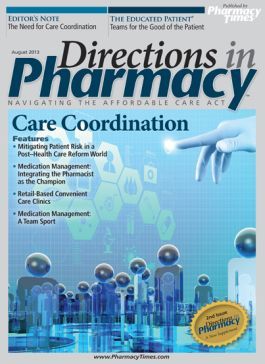Publication
Article
Pharmacy Practice in Focus: Oncology
Medication Reconciliation: The Role of the Pharmacy Technician
Author(s):
The medication reconciliation process helps avoid medication errors and demonstrates the integral contribution of the pharmacy technician.

The medication reconciliation process helps avoid medication errors and demonstrates the integral contribution of the pharmacy technician.
Medication reconciliation is the process of comparing a patient’s medication orders with all of the medications that the patient has been taking prior to admission to the hospital. This is done to avoid medication errors such as omissions, duplications, dosing errors, or drug—drug interactions. This activity is undertaken because the Joint Commission as a 2013 National Patient Safety Goal (NPSG.030601) specifically required (in part):
- Record and pass along correct information about a patient’s medicines.
- Find out what medicines the patient is taking.
Five Steps
As practiced at Inova Alexandria Hospital, the medication reconciliation process comprises 5 steps which are performed by different elements within the continuum of care:
- Develop a list of current medications.
- Develop a list of medications to be ordered/prescribed by the admitting physician.
- Compare the medications on the 2 lists.
- Make clinical decisions based on the comparison.
- Communicate the new list to appropriate caregivers and the patient.
The pharmacy technician is tasked to develop the list of current medications the patient is taking. This is done for patients in the emergency department (ED) who have been identified for admission as well 24 as for patients who have already been admitted and have a diagnosis of congestive heart failure whose medications were not reviewed in the ED.
In addition, the technician is also asked by ED physicians to perform medication reconciliation on patients who, while not being identified for admission, may be taking medications in cases where it would be helpful for the physician to be aware of the specific drug, for example, Pradaxa, digoxin, and other medications.
Medications List
The process undertaken by the pharmacy technician begins with an interview with the patient to ask about their home medications. To be complete and useful to the physicians, this list should include the drug, dose, frequency, and any special circumstances under which the drug in taken. In addition, it is important that OTC products and supplements be included wherever possible. Many patients come to the ED with medication lists and/or bags of medication vials. Experience has shown that these lists and med vials may be incomplete, out of date, or not representative of actual medication-taking schedules and habits.
Further, it is often necessary for the technician to call several sources to gather the information required. Calls have been made to pharmacies, offices of primary care physicians and specialists, nursing and assisted living facilities, and other hospitals and health care providers. With the data collected, the technician enters the information into the health care system which then provides the information to all caregivers with access to that patient information.
Of special importance to the process is the recognition that all of the work performed by the medication reconciliation technician must be reviewed at several levels. These should include ED doctors, admitting doctors, house staff, and unit-based pharmacists who review all discharge medication summaries for congestive heart failure patients and others when review is necessary.
Does the pharmacy technician medication reconciliation process contribute to patient safety and provide a basis for positive outcomes? A study undertaken in 2005 found that “More than half of patients have ≥1 unintended medication discrepancy at hospital admissions.”1 This was broken down as:
6% Severe harm potential 33% Moderate harm potential 61% No harm potential
In 2009, a pilot program instituted in the Inova Alexandria Hospital’s ED found that medication errors in medication lists developed in the ED were in excess of 50%. However, an analysis performed after 2 years of medication reconciliation by the pharmacy technician found an error rate of less than 5%. The key factors that contributed to the success of the program were:
- Support and cooperation of hospital staff, including: Pharmacy director ED medical director Nursing director and staff
- Pharmacy technician knowledge of medications including generic/brand names, standard doses, and classes of drugs used for various conditions.
- Recognition that the job of the pharmacy technician is to help—not to prove anyone wrong.
It has been shown that the pharmacy technician can be an integral part of contributing to patient safety by performing medication reconciliation.
Mark D. Levitz, MA, CPhT, RPhT, is the medication reconciliation technician at Inova Alexandria Hospital Pharmacy in Northern Virginia. He has more than 10 years of experience as a pharmacy technician in retail, military clinic, and hospital environments. He is the program director for the pharmacy technician training program at the Northern Virginia Community College, Medical Education Center in Springfield, Virginia.
References
- Cornish PL, Knowles SR, Marchesano R, et al. Unintended medication discrepancies at the time of hospital admission. Arch Intern Med. 2005;165:424-429.







